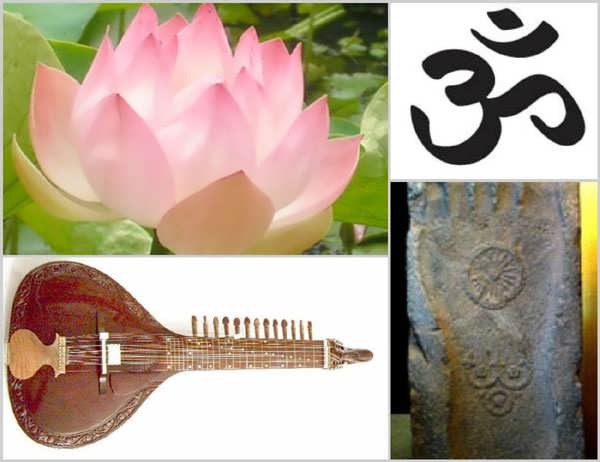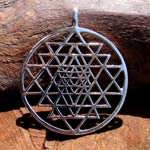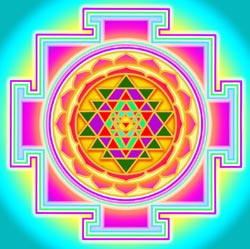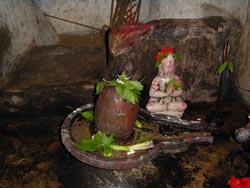 Bindi – One of the most well-known items in Hinduism is the bindi, a dot (often the colour red) worn on women’s foreheads. It is a form of the tilak, a symbolic mark worn by many Hindu men and women, but that has less religious meaning than other tilaks. Traditionally, the bindi is worn on the forehead of married Hindu women. It symbolizes female energy and is believed to protect women and their husbands from bad things. Bindis are traditionally a simple mark made with the paste of coloured sandalwood, sindoor or turmeric. The bindi is most commonly a red dot made with vermilion. Bindi – One of the most well-known items in Hinduism is the bindi, a dot (often the colour red) worn on women’s foreheads. It is a form of the tilak, a symbolic mark worn by many Hindu men and women, but that has less religious meaning than other tilaks. Traditionally, the bindi is worn on the forehead of married Hindu women. It symbolizes female energy and is believed to protect women and their husbands from bad things. Bindis are traditionally a simple mark made with the paste of coloured sandalwood, sindoor or turmeric. The bindi is most commonly a red dot made with vermilion. |
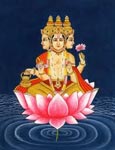 Brahman – One can say that Brahman Itself (him/herself) constitutes the essential building material of all reality, being the substance from which all things proceed. Brahman, as understood by the scriptures of Hinduism, as well as by the ‘acharyas’ of the Vedanta school, is a very specific conception of the absolute. Any other religion on earth has not replicated this unique conception to this day, and it is exclusive to Hinduism. Brahman – One can say that Brahman Itself (him/herself) constitutes the essential building material of all reality, being the substance from which all things proceed. Brahman, as understood by the scriptures of Hinduism, as well as by the ‘acharyas’ of the Vedanta school, is a very specific conception of the absolute. Any other religion on earth has not replicated this unique conception to this day, and it is exclusive to Hinduism. |
Fire Altar –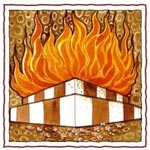 The fire altar is regarded as a distinct symbol of ancient Vedic rites. The Hindus make offerings to the Gods through the fire element, denoting divine consciousness. Hindu sacraments are solemnized before the fire. The fire altar is regarded as a distinct symbol of ancient Vedic rites. The Hindus make offerings to the Gods through the fire element, denoting divine consciousness. Hindu sacraments are solemnized before the fire. |
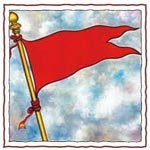 Dhvaja, or ‘flag,’ is the orange or red banner flown above temples, at festivals, and in processions. It is a symbol of victory, a signal to all that “Sanatana Dharma shall prevail.” Its colour betokens the sun’s life-giving glow. Dhvaja, or ‘flag,’ is the orange or red banner flown above temples, at festivals, and in processions. It is a symbol of victory, a signal to all that “Sanatana Dharma shall prevail.” Its colour betokens the sun’s life-giving glow. |
 Vata, the banyan tree, symbolizes Hinduism, which branches out in all directions, draws from many roots, and spreads shade far and wide, yet stems from one great trunk. Siva, as Silent Sage, sits beneath it. Vata, the banyan tree, symbolizes Hinduism, which branches out in all directions, draws from many roots, and spreads shade far and wide, yet stems from one great trunk. Siva, as Silent Sage, sits beneath it. |
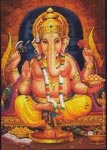 Ganesha is the Lord of Obstacles and Ruler of Dharma. Seated upon His throne, He guides our karmas by creating and removing obstacles from our path. We seek His permission and blessings in every undertaking. Ganesha is the Lord of Obstacles and Ruler of Dharma. Seated upon His throne, He guides our karmas by creating and removing obstacles from our path. We seek His permission and blessings in every undertaking. |
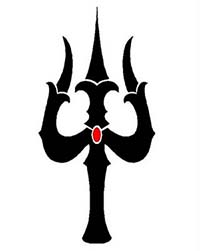 The Trishula – Trishula or the Trident is a prominent Hindu symbol that is associated with Lord Shiva. Though this three-pronged symbol is usually viewed as a weapon used by the Lord for the protection and restoration of Dharma, it actually carries deeper meanings. It is representative of the Trinity of Brahma, Vishnu, and Mahesh and stands for the balance between the forces of creation, preservation, and destruction. It is also considered symbolic of the three Gunas – Rajas, Tamas and Sattva. Another symbolic representation of the Trishula is that of the three facets of consciousness, namely, cognition, affection, and conation. The Trishula – Trishula or the Trident is a prominent Hindu symbol that is associated with Lord Shiva. Though this three-pronged symbol is usually viewed as a weapon used by the Lord for the protection and restoration of Dharma, it actually carries deeper meanings. It is representative of the Trinity of Brahma, Vishnu, and Mahesh and stands for the balance between the forces of creation, preservation, and destruction. It is also considered symbolic of the three Gunas – Rajas, Tamas and Sattva. Another symbolic representation of the Trishula is that of the three facets of consciousness, namely, cognition, affection, and conation. |
 Tripundra – The Tripundra is a prominent Hindu symbol that is used by Shaivites or the devotees of Lord Shiva. Tripundra is typically a tilak, with three horizontal lines made from Bhasma or sacred ash applied on the forehead. It may have a red dot or Bindu superimposed in the center. Some Shiva followers also draw the three ash strips of Tripundra on the sides of their arms.The Tripundra represents the three godly forces of creation, sustenance, and destruction through the three lines, while the ashes symbolize purification and burning away of Anava (ego), Maya (illusions) and karma (actions/deeds). The dot is symbolic of the rise or quickening of spiritual insight. Tripundra – The Tripundra is a prominent Hindu symbol that is used by Shaivites or the devotees of Lord Shiva. Tripundra is typically a tilak, with three horizontal lines made from Bhasma or sacred ash applied on the forehead. It may have a red dot or Bindu superimposed in the center. Some Shiva followers also draw the three ash strips of Tripundra on the sides of their arms.The Tripundra represents the three godly forces of creation, sustenance, and destruction through the three lines, while the ashes symbolize purification and burning away of Anava (ego), Maya (illusions) and karma (actions/deeds). The dot is symbolic of the rise or quickening of spiritual insight. |
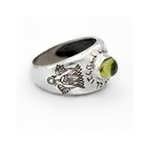
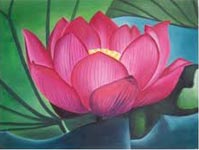
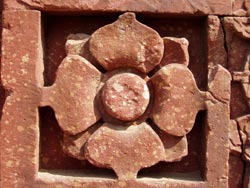
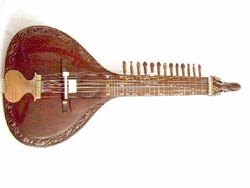
 Bindi – One of the most well-known items in Hinduism is the bindi, a dot (often the colour red) worn on women’s foreheads. It is a form of the tilak, a symbolic mark worn by many Hindu men and women, but that has less religious meaning than other tilaks. Traditionally, the bindi is worn on the forehead of married Hindu women. It symbolizes female energy and is believed to protect women and their husbands from bad things. Bindis are traditionally a simple mark made with the paste of coloured sandalwood, sindoor or turmeric. The bindi is most commonly a red dot made with vermilion.
Bindi – One of the most well-known items in Hinduism is the bindi, a dot (often the colour red) worn on women’s foreheads. It is a form of the tilak, a symbolic mark worn by many Hindu men and women, but that has less religious meaning than other tilaks. Traditionally, the bindi is worn on the forehead of married Hindu women. It symbolizes female energy and is believed to protect women and their husbands from bad things. Bindis are traditionally a simple mark made with the paste of coloured sandalwood, sindoor or turmeric. The bindi is most commonly a red dot made with vermilion. Brahman – One can say that Brahman Itself (him/herself) constitutes the essential building material of all reality, being the substance from which all things proceed. Brahman, as understood by the scriptures of Hinduism, as well as by the ‘acharyas’ of the Vedanta school, is a very specific conception of the absolute. Any other religion on earth has not replicated this unique conception to this day, and it is exclusive to Hinduism.
Brahman – One can say that Brahman Itself (him/herself) constitutes the essential building material of all reality, being the substance from which all things proceed. Brahman, as understood by the scriptures of Hinduism, as well as by the ‘acharyas’ of the Vedanta school, is a very specific conception of the absolute. Any other religion on earth has not replicated this unique conception to this day, and it is exclusive to Hinduism. The fire altar is regarded as a distinct symbol of ancient Vedic rites. The Hindus make offerings to the Gods through the fire element, denoting divine consciousness. Hindu sacraments are solemnized before the fire.
The fire altar is regarded as a distinct symbol of ancient Vedic rites. The Hindus make offerings to the Gods through the fire element, denoting divine consciousness. Hindu sacraments are solemnized before the fire. Dhvaja, or ‘flag,’ is the orange or red banner flown above temples, at festivals, and in processions. It is a symbol of victory, a signal to all that “Sanatana Dharma shall prevail.” Its colour betokens the sun’s life-giving glow.
Dhvaja, or ‘flag,’ is the orange or red banner flown above temples, at festivals, and in processions. It is a symbol of victory, a signal to all that “Sanatana Dharma shall prevail.” Its colour betokens the sun’s life-giving glow. Vata, the banyan tree, symbolizes Hinduism, which branches out in all directions, draws from many roots, and spreads shade far and wide, yet stems from one great trunk. Siva, as Silent Sage, sits beneath it.
Vata, the banyan tree, symbolizes Hinduism, which branches out in all directions, draws from many roots, and spreads shade far and wide, yet stems from one great trunk. Siva, as Silent Sage, sits beneath it. Ganesha is the Lord of Obstacles and Ruler of Dharma. Seated upon His throne, He guides our karmas by creating and removing obstacles from our path. We seek His permission and blessings in every undertaking.
Ganesha is the Lord of Obstacles and Ruler of Dharma. Seated upon His throne, He guides our karmas by creating and removing obstacles from our path. We seek His permission and blessings in every undertaking. The Trishula – Trishula or the Trident is a prominent Hindu symbol that is associated with Lord Shiva. Though this three-pronged symbol is usually viewed as a weapon used by the Lord for the protection and restoration of Dharma, it actually carries deeper meanings. It is representative of the Trinity of Brahma, Vishnu, and Mahesh and stands for the balance between the forces of creation, preservation, and destruction. It is also considered symbolic of the three Gunas – Rajas, Tamas and Sattva. Another symbolic representation of the Trishula is that of the three facets of consciousness, namely, cognition, affection, and conation.
The Trishula – Trishula or the Trident is a prominent Hindu symbol that is associated with Lord Shiva. Though this three-pronged symbol is usually viewed as a weapon used by the Lord for the protection and restoration of Dharma, it actually carries deeper meanings. It is representative of the Trinity of Brahma, Vishnu, and Mahesh and stands for the balance between the forces of creation, preservation, and destruction. It is also considered symbolic of the three Gunas – Rajas, Tamas and Sattva. Another symbolic representation of the Trishula is that of the three facets of consciousness, namely, cognition, affection, and conation. Tripundra – The Tripundra is a prominent Hindu symbol that is used by Shaivites or the devotees of Lord Shiva. Tripundra is typically a tilak, with three horizontal lines made from Bhasma or sacred ash applied on the forehead. It may have a red dot or Bindu superimposed in the center. Some Shiva followers also draw the three ash strips of Tripundra on the sides of their arms.The Tripundra represents the three godly forces of creation, sustenance, and destruction through the three lines, while the ashes symbolize purification and burning away of Anava (ego), Maya (illusions) and karma (actions/deeds). The dot is symbolic of the rise or quickening of spiritual insight.
Tripundra – The Tripundra is a prominent Hindu symbol that is used by Shaivites or the devotees of Lord Shiva. Tripundra is typically a tilak, with three horizontal lines made from Bhasma or sacred ash applied on the forehead. It may have a red dot or Bindu superimposed in the center. Some Shiva followers also draw the three ash strips of Tripundra on the sides of their arms.The Tripundra represents the three godly forces of creation, sustenance, and destruction through the three lines, while the ashes symbolize purification and burning away of Anava (ego), Maya (illusions) and karma (actions/deeds). The dot is symbolic of the rise or quickening of spiritual insight.

